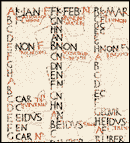 "The Romans borrowed parts of their earliest known calendar from the Greeks. The calendar consisted of 10 months in a year of 304 days. The Romans seem to have ignored the remaining 61 days, which fell in the middle of winter. The 10 months were named Martius, Aprilis, Maius, Junius, Quintilis, Sextilis, September, October, November, and December. The last six names were taken from the words for five, six, seven, eight, nine, and ten. Romulus, the legendary first ruler of Rome, is supposed to have introduced this calendar in the 700's B.C.E.
"The Romans borrowed parts of their earliest known calendar from the Greeks. The calendar consisted of 10 months in a year of 304 days. The Romans seem to have ignored the remaining 61 days, which fell in the middle of winter. The 10 months were named Martius, Aprilis, Maius, Junius, Quintilis, Sextilis, September, October, November, and December. The last six names were taken from the words for five, six, seven, eight, nine, and ten. Romulus, the legendary first ruler of Rome, is supposed to have introduced this calendar in the 700's B.C.E.
According to tradition, the Roman ruler Numa Pompilius added January and February to the calendar. This made the Roman year 355 days long. To make the calendar correspond approximately to the solar year, Numa also ordered the addition every other year of a month called Mercedinus. Mercedinus was inserted after February 23 or 24, and the last days of February were moved to the end of Mercedinus. In years when it was inserted, Mercedinus added 22 or 23 days to the year."
No comments:
Post a Comment